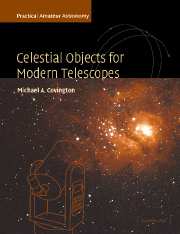Book contents
- Frontmatter
- Contents
- Preface
- Part I Amateur astronomy
- 1 Using this book effectively
- 2 Observing sites and conditions
- 3 The Moon, the Sun, and eclipses
- 4 The planets
- 5 Comets, asteroids (minor planets), and artificial satellites
- 6 Constellations
- 7 Stars – identification, nomenclature, and maps
- 8 Stars – physical properties
- 9 Double and multiple stars
- 10 Variable stars
- 11 Clusters, nebulae, and galaxies
- Part II 200 interesting stars and deep-sky objects
- Appendices
- Index
9 - Double and multiple stars
Published online by Cambridge University Press: 22 September 2009
- Frontmatter
- Contents
- Preface
- Part I Amateur astronomy
- 1 Using this book effectively
- 2 Observing sites and conditions
- 3 The Moon, the Sun, and eclipses
- 4 The planets
- 5 Comets, asteroids (minor planets), and artificial satellites
- 6 Constellations
- 7 Stars – identification, nomenclature, and maps
- 8 Stars – physical properties
- 9 Double and multiple stars
- 10 Variable stars
- 11 Clusters, nebulae, and galaxies
- Part II 200 interesting stars and deep-sky objects
- Appendices
- Index
Summary
The importance of double stars
More than half of all stars belong to double- or multiple-star systems. That is, they are gravitationally bound to other stars and orbit around the system's common center of gravity.
Amateur astronomers today have forgotten the excitement that accompanied the gradual discovery of this fact during the nineteenth century. Double stars provided the first opportunity to measure the mass of stars and to test the laws of physics outside the Solar System.
Many double stars show measurable orbital motion over just a few years. Many others need to be measured now, since determination of an orbit requires observations many years or centuries apart, and double-star work fell out of fashion in the twentieth century. The Hipparcos satellite made accurate measurements of numerous double stars in early 1991; even these observations are now old enough that it is worth while looking for subsequent changes.
It is often unknown whether a particular double is really a gravitationally bound binary star or merely an optical double comprising two unrelated stars in the same line of sight. In between are common proper motion pairs, stars that appear to be the same distance from Earth and have roughly the same proper motion, but in which orbital motion has not been observed.
A visual binary is a binary star whose orbit can be observed with telescopes. Less than a thousand orbits are known in any detail, and the available information about them is often inaccurate.
- Type
- Chapter
- Information
- Celestial Objects for Modern TelescopesPractical Amateur Astronomy Volume 2, pp. 123 - 131Publisher: Cambridge University PressPrint publication year: 2002



